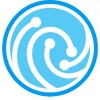For the past fifty years, Volna Engineering has provided one-of-a-kind solutions to difficult measurement and tooling problems for the aerospace and defense industries. Removal of constraints, one at a time, allows additional degrees of freedom for a specific task in any machine or measuring instrument. A machine element with one necessary degree of freedom and more than five degrees of constraint will have uncertain performance (hysteresis), higher friction, and higher cost.
If you are currently planning a device, product, or machine that must possess high precision performance for the least cost, consider the use of "kinematic coupling" design principles. Contact Volna Engineering for consulting fees and possible fabrication details. One day seminars are encouraged.
Embodying the principles of "kinematic coupling, " these roll-tumble, two-axis test tables were built for testing of Honeywell ring-laser navigation systems and have been in service for 19 years with unchanging sub-arc-second accuracy.
If you are currently planning a device, product, or machine that must possess high precision performance for the least cost, consider the use of "kinematic coupling" design principles. Contact Volna Engineering for consulting fees and possible fabrication details. One day seminars are encouraged.
Embodying the principles of "kinematic coupling, " these roll-tumble, two-axis test tables were built for testing of Honeywell ring-laser navigation systems and have been in service for 19 years with unchanging sub-arc-second accuracy.
Services
VTASRoll PitchHelmetFixture
Report
Designed for the Armstrong Laboratory, Wright Patterson Air Force Base, this Visual Target Acquisition System (VTAS) fixture provides two coincident axes of helmet rotation about a simulated tragion (top of the spinal column).
Three-point kinematic couples employed in this device have given arc-minute pitch-and-roll data, free of play or hysteresis, for over 20 years.
Three-point kinematic couples employed in this device have given arc-minute pitch-and-roll data, free of play or hysteresis, for over 20 years.
Bill'sRetirementSandbox
Report
You are invited to look at Bill Volna's Retirement Sandbox.
Having recently reached the age of eighty-six, Bill, a mechanical engineer, has put together this addition to his website for your enjoyment.
The Sandbox is a small block building that Bill built with the help of his dad, Max, and nephew, Steven, in 1968.
It became the home of Volna Engineering Company.
Bill, now retired, goes almost every day to his "Sandbox" - sometimes called the Volna Engineering Tech School - and enjoys life with his numerous interests, including mentoring younger enthusiasts with their hobbies.
Having recently reached the age of eighty-six, Bill, a mechanical engineer, has put together this addition to his website for your enjoyment.
The Sandbox is a small block building that Bill built with the help of his dad, Max, and nephew, Steven, in 1968.
It became the home of Volna Engineering Company.
Bill, now retired, goes almost every day to his "Sandbox" - sometimes called the Volna Engineering Tech School - and enjoys life with his numerous interests, including mentoring younger enthusiasts with their hobbies.
TARDIS II:Intro-duction
Report
TARDIS I, finished in 1989, has provided an enriching experience for hundreds of school children and adults in several American cities.
On loan to the National Science Foundation, it served scientists at the Amundsen/ Scott South pole station for two years without failure at -100 F.
The objective in building TARDIS II, a design proven with TARDIS I, is to create a telescope which will provide a safe, comfortable viewing experience for people who are physically challenged.
Before TARDIS II, a person in a wheel chair could not possibly enjoy the raw beauty of the planet Saturn, Jupiter, or the craters on the Moon, other than artificially by digital electronic devices.
On loan to the National Science Foundation, it served scientists at the Amundsen/ Scott South pole station for two years without failure at -100 F.
The objective in building TARDIS II, a design proven with TARDIS I, is to create a telescope which will provide a safe, comfortable viewing experience for people who are physically challenged.
Before TARDIS II, a person in a wheel chair could not possibly enjoy the raw beauty of the planet Saturn, Jupiter, or the craters on the Moon, other than artificially by digital electronic devices.
Reviews

Be the first to review William M Volna Engineering.
Write a Review